We are almost half way into the end of the first half of the year so I think it’s good that we do another round of review on the latest S-Reits universe update.
For those who are interested in the last quarterly update, you can view them here where the theme was on gearing and sensitivity risk of increase borrowing costs on their respective profile.


Performance YTD
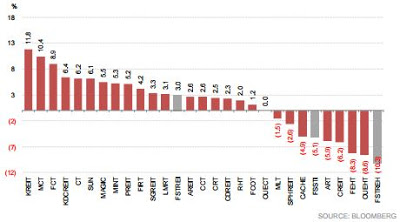
Let’s first start with how Reits have performed in 2016 Year to date:
- Please note that this is only based on capital gain, excluding dividends.
- Gone are the days where we see double digit abnormally high returns like what we’ve seen in 2013. Still, if you pick the right Reits to invest in, investors can still achieve double digit returns if we include dividends in.
- The top 3 best performing Reits currently goes to Keppel Reit, Mapletree Commercial Reit (MCT) and Fraser Centerpoint Trust (FCT). For some reason, Ireit (9% capital gain return) was not included inside the list. I think it’ll make a strong candidate for the best performing if it was included.
- The bottom 3 worst performing Reits currently goes to OUE Hospitality Trust (OUEHT), Far East Hospitality Trust (FEHT) and Cambridge Industrial Trust (CReit). Ironically, these 3 have one of the lowest price-to-book value compared to the rest. This is precisely why buying based on a discount to the price to book value without further understanding the nature of the business or assets can be detrimental to your overall portfolio returns.

Valuations
If we look through the valuations of the overall Reits, we can see that they are within the boundary range of the average line in the past 14 years.
There were an obvious period of bubble territory formed from 2003 to 2007 when the yield dropped to about 4% and P/BV goes as high as 1.5x before it went crashing during the GFC period. At the trough during the GFC, yield for Reits can go as high as 12% on average while the P/BV drops to 0.5x.
We are somewhere in the middle right now, but to wait until valuations go to such level we’ve seen during the GFC, it may or may not materialize at the end of the day. Just waiting for it to happen can lose you opportunity cost during these periods where you can still earn double digit return (see above) provided you pick the right company to invest.
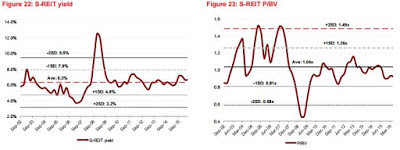
Next, I’ll go into a bit more specific into each respective sectors:
Office Sector
I’ve shared quite a bit on the office sectors in the past few articles.
If you look at the near term supply of commercial properties in the next 2-3 years, you will see that there are a lot of supply coming and this will dampen the rental yield of a commercial property. This is similar to what we’ve seen in 2011 back then when it is forecast that there will be major supply in 2012. Rental yield should remain depress until 2018 before bouncing back.
Still, do look out for leases expiry profile of your respective Reits to know how much will it impact the overall portfolio.
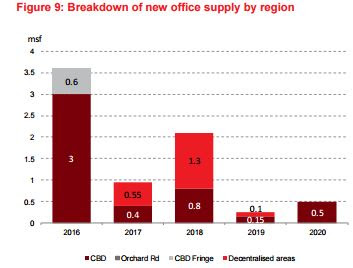
Hospitality Sector
Hospitality is another sector facing pressure from incoming supply for the next 2 – 3 years.
The 3 year CAGR is expected to be at around 3.8%, but coupled this with the strong SGD, we may be seeing some downward pressure in the rev/par unless the demand can keep up. The Singapore government has set aside $700 million in a Tourism Development Fund to be invested from 2016 to 2020 and they are forecasting a growth of between 1-3% over the next 3 years.
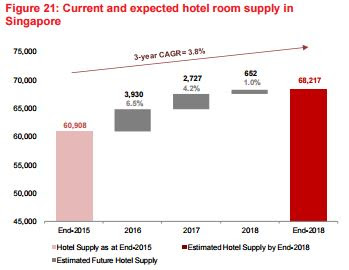

Retail Sector
There are a couple more supply coming in the next 2 – 3 years mainly from the completion of Northpoint integration mall in outskirt of town, the rest should be more subdued.
If you own a piece of the retail reits, do watch out for tenant retention, sales traffic and historical rental reversion in particular, as this will show how good a management is doing their job to maximize returns.
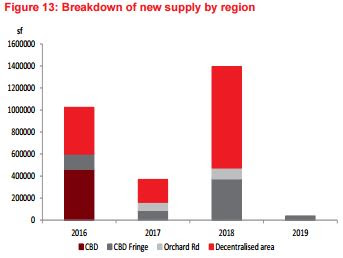
Final Thoughts
Reits have been a popular investments for many people over the years. Like any other investment vehicle, there are the good and bad ones.
There are also a group of people who shuns Reits in general because they feel they are not able to grow due to the very small earnings they retained. This is not true because there are many example of good Reits where their management are able to work something out to grow organically through positive rental reversion and maximizing the asset’s return. There are also a couple of Reits which have the history of not raising any rights to investors in order to grow.
As with any investment, the key is to understand the nature of the underlying assets and management of a Reit better and earlier than what the general public can see on the outside. If you can do that, Reits can be an extremely lucrative investment because it offers you a great dividend plus capital gain yield.
*Vested with Ireit, FCT, CCT, Ascott, Keppel DC and First Reit as of writing.


I own 2 of the TOP REITs and 3 of the Bottom REITs you mentioned. 🙁
take heart.
i own 2 of the bottom, none of the top. haha.
Hi SR & FC
Wah you guys are so much into hospitality counter!!!
B,
i was bullish on tourism..
and, still am =)
B,
how about gearing levels of reits?
in your opinion, what would be an ideal % of gear level?
Hi FC
My thinking is a bit different from the rest.
Contrary to many people, I like Reits to gear up as much as possible, provided they are able to obtain cheap financing. I think by doing that, the management is maximizing the optimal source of capital allocation which can boost the return of the company.
Of course, ideally it is more prudent to have a lesser gearing but if it is cheap, then why not? Of course, leave some room in case there are margins of error so I would say it depends on the financing term and loan.
B,
i am of the same view as well, especially for reits.
noticed most of the are around ~35% gearing level. however, with the impending interest rate hike sometime this year. some of them might struggle.
eToro is the ultimate forex trading platform for rookie and professional traders.